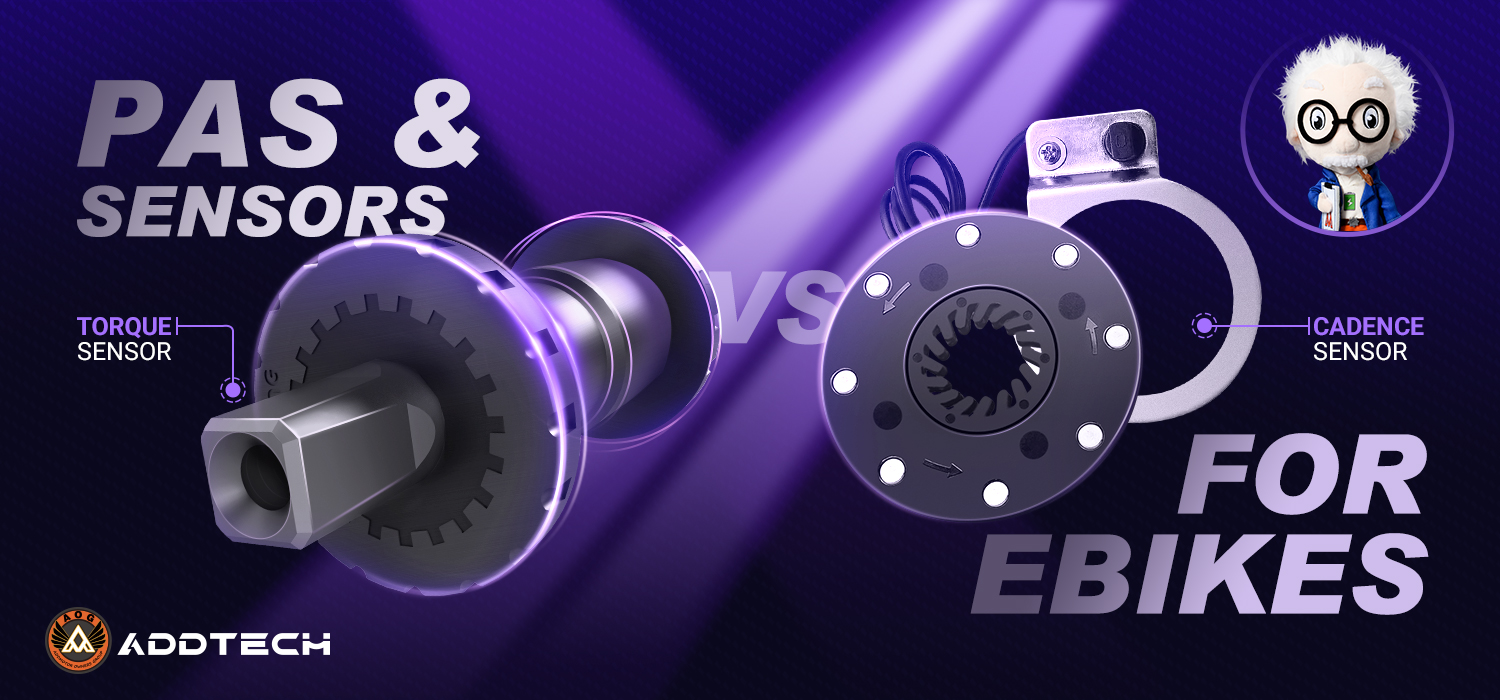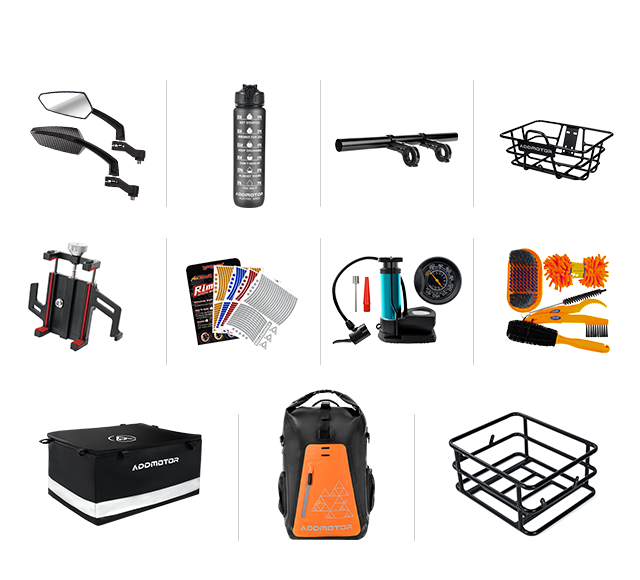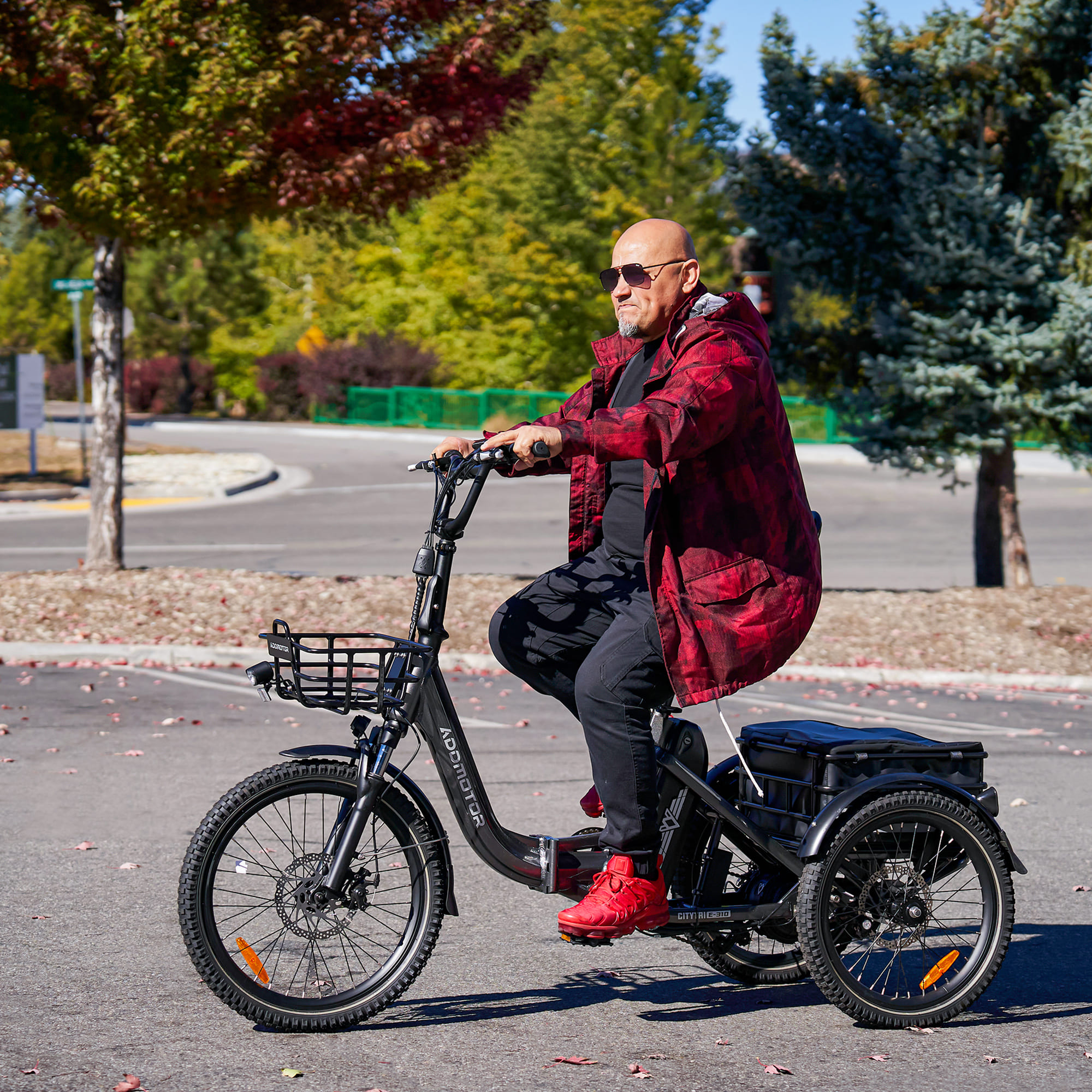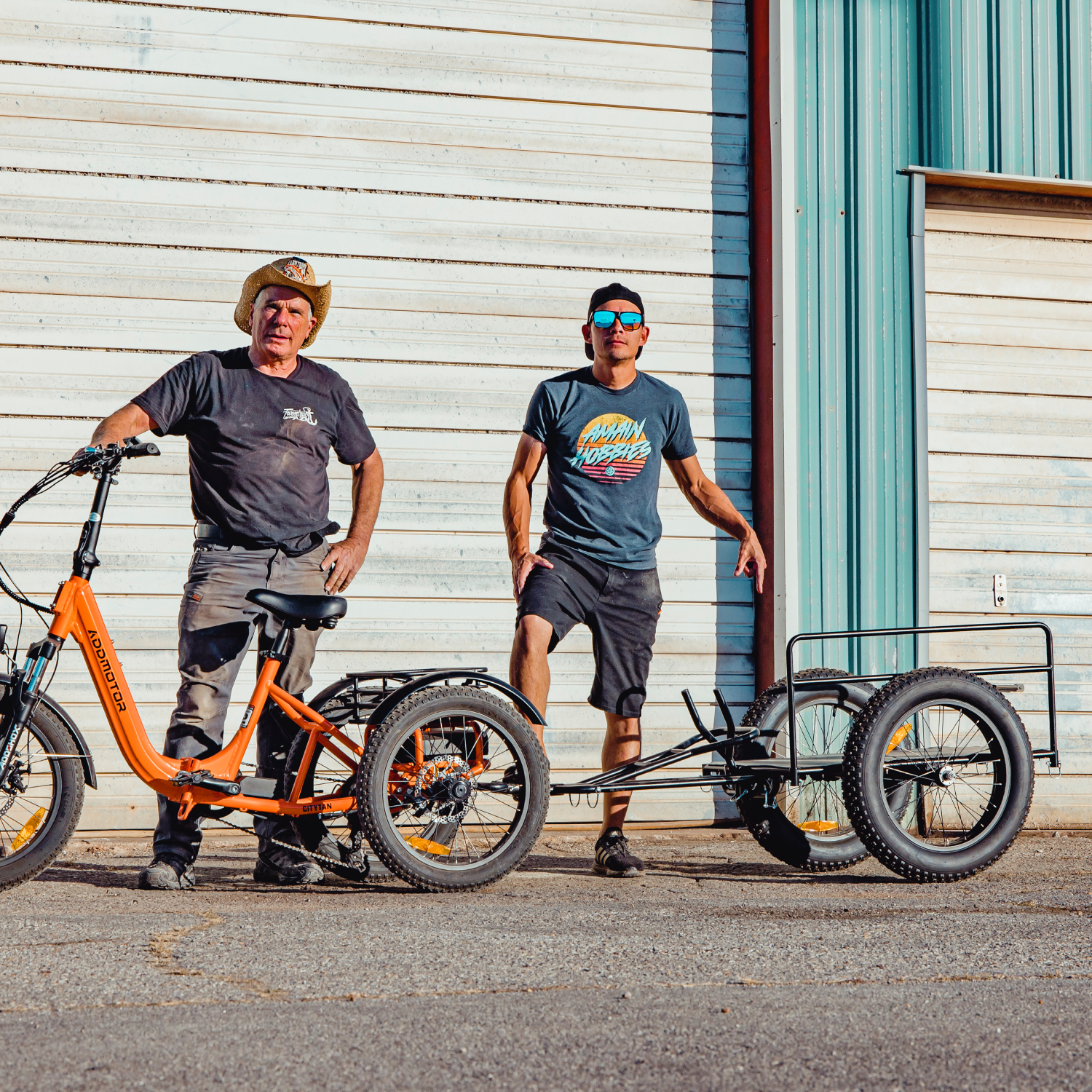ADDTECH | Ebike Electrical Components-PAS & Sensors
By Addmotor | 29 February 2024 | 0 Comments
Electric bikes are popularly known for their unique features that provide various benefits and allow convenience in life. One of the major features of an e-bike that sets it apart from regular bicycles is the electric bike pedal assist system. The e-bike pedal assist allows you to ride the e-bike effortlessly as the motor delivers the power to the e-bike pedal assist and helps it to propel forward while you pedal with minimum effort. E-bike pedal assist plays a crucial role in determining the performance and efficiency of an electric bike. So let's see how the e-bike pedal assist works, its benefits, and the types of e-bike pedal assist systems you may find in the market.

Cadence sensors aren’t complex, simple to understand, and easy to use as they require minimum effort from the riders to activate the e-bike pedal assist. The riders do not have to pedal hard or put in maximum effort as the sensors only detect the pedaling speed to activate the electric motor instead of the force put into the pedaling.
• Cheaper
Due to its simpler function and design, the cadence sensor is relatively cheaper than the other types of sensor. Since the cadence sensor isn’t involved in any complexity and only detects the speed of the pedaling, it is quite cheaper to design and apply to the electric bike, hence also reducing the overall cost of the electric bike.
• Consistent and smooth assistance
Since the cadence sensor doesn’t rely on other factors such as force or type of terrain to activate e-bike pedal assist, the cadence sensor provides smooth and consistent pedal assistance as you pedal the electric bike.
Cadence sensor relies only on the speed of the pedaling, since it is less precise, it may be less responsive to any changes in pedaling speed or the terrain. The motor activation may be delayed, and the sensor may not be able to adapt to the change.
• Feel less intuitive
As the cadence sensor works like an on-and-off switch, the e-bike pedal assist starts immediately as you begin pedaling, not giving enough time to the riders to feel indulged in cycling, especially when intending to do a workout.
• Less range
Another disadvantage of a cadence sensor is that it allows you to cover a lesser distance on a single charge as compared to a torque sensor. It provides power consistently at the same level of pedal assist, and the battery is consumed in greater amounts. The activation of the electric motor also consumes larger amounts of battery, thus reducing the range of the e-bike.
Riding an e-bike with a torque sensor gives a more natural and intuitive feel to the riders as the pedal assist delivered by the electric motor is directly linked to their pedaling effort. The electric motor only provides as much power as needed according to their pedaling and doesn’t deliver a sudden surge of power as they pedal.
• Provides more range
Unlike the cadence sensor, the torque sensor doesn’t signal the electric motor to provide power consistently at the same level of pedal assist. It optimizes the power delivery according to the pedaling effort of the rider and allows it to cover an extended range.
Compared to the basic cadence sensor, the torque sensor is more expensive which ultimately increases the overall cost of an electric bike.
• Requires more effort
For maximum pedal assistance and top speed, the riders have to put in a lot of effort in pedaling an e-bike with a torque sensor as the motor delivers the power based on the efforts of pedaling.
• Complex
Another disadvantage of the torque sensor is that, compared to the cadence sensor, the torque sensor is more complex in design and function, which may require a high maintenance or repair cost.
You may find a huge variety of electric bikes and trikes with cadence sensors available in the market. You may also find them at Addmotor. Not only this, but Addmotor also has various latest models of electric bikes and electric trikes with torque sensors, including the Arisetan M-360, the popular Grandtan Series, Triketan M-330 Series e-trikes, M-160 folding e-bike, and Graoopro e-bikes. So if you are looking for an electric bike or electric trike with torque sensor, you can head over to our website now and find a suitable one for yourself.

What is an E-bike pedal assist system?
The e-bike pedal assist is an operating mode of an e-bike that triggers the electric motor to deliver the power needed during pedaling to propel the bike forward. It decreases the amount of work required during pedaling and helps you to effortlessly ride the e-bike and cover long distances without getting tired or having muscle cramps. Electric bikes have different levels of pedal assist, designed to assist according to the efforts the riders would like to put in during pedaling.How does e-bike pedal assist work?
The e-bike pedal assist works based on sensors present in the drivetrain of the electric bike. Two types of sensors are present in e-bike pedal assist, cadence sensor and torque sensor. These sensors detect that you have started pedaling or the amount of effort you put in during pedaling and send signals to the electric motor. The electric motor then activates and delivers the power to the pedals according to the level of pedal assistance you require to make the riding experience effortless. Some electric bikes have 7 or some have 5 levels of e-bike pedal assist, starting from zero to maximum level of assistance. Addmotor electric bikes use a 7-level pedal assist system to make your ride more relaxed and effortless.Benefits of e-bike pedal assist system
There are various benefits of e-bike pedal assist that make electric bikes popular in the market. Some of the benefits include:• Greener mobility
Since gas-powered vehicles have negatively impacted our environment due to the emission of harmful gases, many people are trying to switch towards greener mobility. E-bike pedal assist plays a huge role in providing a convenient and sustainable mode of transportation, reducing the dependence upon cars and motorcycles.• Low-impact exercise
If you have been delaying workouts, joining a gym, or cycling seems like a lot of work, then e-bike pedal assist is made for you. You may do pedaling just like on a regular bicycle, but the e-bike pedal assist will make it easier for you and won't make you feel tired. You may set goals and increase your fitness by choosing the level of pedal assistance you may require.• Longer commutes
It seems an impossible task to pedal and commute longer distances on a bicycle as it can be tiring and exhausting. But with the help of e-bike pedal assist, longer commutes become convenient as the extra force by the electric motor makes pedaling effortless, and allows you to reach your destination without breaking much sweat.• Accessible for everyone
Many adults or people with joint pain or mobility issues are unable to ride a bicycle as it requires strength and puts strain on the joints. E-bike pedal assist mode has made mobility quite convenient for adults and people with mobility issues, as it divides the force exerted by the riders and requires less strength while pedaling. So adults wanting to maintain fitness or cardiovascular endurance and people with joint pain or injuries can conveniently ride an electric bike with pedal assist.Types of e-bike pedal assist sensors
Sensors play a crucial role in the e-bike pedal assist system as they activate the electric motor as you start pedaling and deliver the power to the pedals. As we said above, there are two types of e-bike pedal assist sensors, the torque sensor and the cadence sensor. Let's see how each works and their pros and cons.♦ Cadence sensor
A cadence sensor is the basic type of sensor that activates the electric motor by sending signals to the controller as you start pedaling and turns off the electric motor as you stop pedaling. It doesn’t matter how hard you pedal, the cadence sensor detects the rotation of the crank arms or in simple words, the movement of the pedals and activates the electric motor. This sensor is attached to the frame of the electric bike near the bracket, and the magnets are present at the crank that passes by the sensor as you pedal. Let's look at some pros and cons of cadence sensors, which may help you decide if you should choose an e-bike with a cadence sensor.Pros
• Simple and easy to useCadence sensors aren’t complex, simple to understand, and easy to use as they require minimum effort from the riders to activate the e-bike pedal assist. The riders do not have to pedal hard or put in maximum effort as the sensors only detect the pedaling speed to activate the electric motor instead of the force put into the pedaling.
• Cheaper
Due to its simpler function and design, the cadence sensor is relatively cheaper than the other types of sensor. Since the cadence sensor isn’t involved in any complexity and only detects the speed of the pedaling, it is quite cheaper to design and apply to the electric bike, hence also reducing the overall cost of the electric bike.
• Consistent and smooth assistance
Since the cadence sensor doesn’t rely on other factors such as force or type of terrain to activate e-bike pedal assist, the cadence sensor provides smooth and consistent pedal assistance as you pedal the electric bike.
Cons
• Less responsive and inefficientCadence sensor relies only on the speed of the pedaling, since it is less precise, it may be less responsive to any changes in pedaling speed or the terrain. The motor activation may be delayed, and the sensor may not be able to adapt to the change.
• Feel less intuitive
As the cadence sensor works like an on-and-off switch, the e-bike pedal assist starts immediately as you begin pedaling, not giving enough time to the riders to feel indulged in cycling, especially when intending to do a workout.
• Less range
Another disadvantage of a cadence sensor is that it allows you to cover a lesser distance on a single charge as compared to a torque sensor. It provides power consistently at the same level of pedal assist, and the battery is consumed in greater amounts. The activation of the electric motor also consumes larger amounts of battery, thus reducing the range of the e-bike.
♦ Torque sensor
Another type of sensor used in e-bike pedal assist and is popularly being used in electric bikes and electric trikes is the torque sensor, which is an advanced sensor compared to the cadence sensor. The torque sensor detects how much effort is being put in by the rider during pedaling and signals the electric motor to deliver the power accordingly. The harder the rider pedals, the more power is delivered by the electric motor, and greater assistance is provided. It consists of a precise gauge to measure the intensity of the pedaling and assist accordingly. So let's look at the pros and cons of the torque sensor.Pros
• More intuitiveRiding an e-bike with a torque sensor gives a more natural and intuitive feel to the riders as the pedal assist delivered by the electric motor is directly linked to their pedaling effort. The electric motor only provides as much power as needed according to their pedaling and doesn’t deliver a sudden surge of power as they pedal.
• Provides more range
Unlike the cadence sensor, the torque sensor doesn’t signal the electric motor to provide power consistently at the same level of pedal assist. It optimizes the power delivery according to the pedaling effort of the rider and allows it to cover an extended range.
Cons
• ExpensiveCompared to the basic cadence sensor, the torque sensor is more expensive which ultimately increases the overall cost of an electric bike.
• Requires more effort
For maximum pedal assistance and top speed, the riders have to put in a lot of effort in pedaling an e-bike with a torque sensor as the motor delivers the power based on the efforts of pedaling.
• Complex
Another disadvantage of the torque sensor is that, compared to the cadence sensor, the torque sensor is more complex in design and function, which may require a high maintenance or repair cost.
Torque vs cadence sensor. Which one is better?
Based on the pros and cons, the two types of e-bike pedal assist sensors cannot be classified as best or worst, but you can choose between them by considering various factors that depend upon your riding experience. If you want a more natural and efficient riding experience, regardless of the cost, you can opt for an electric bike with a torque sensor. But if you want a total effortless riding experience that is light on your pocket, then an e-bike with a cadence sensor will be suitable for you.You may find a huge variety of electric bikes and trikes with cadence sensors available in the market. You may also find them at Addmotor. Not only this, but Addmotor also has various latest models of electric bikes and electric trikes with torque sensors, including the Arisetan M-360, the popular Grandtan Series, Triketan M-330 Series e-trikes, M-160 folding e-bike, and Graoopro e-bikes. So if you are looking for an electric bike or electric trike with torque sensor, you can head over to our website now and find a suitable one for yourself.
Leave a Reply
Your email address will not be published.Required fields are marked. *
Latest Stories




